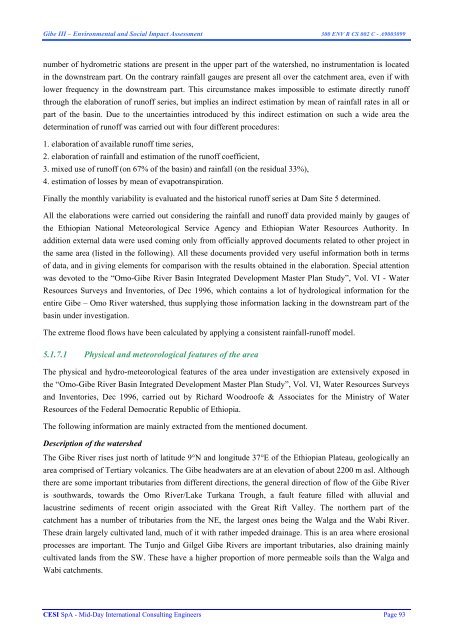Environmental and Social Impact Assessment - Gibe III
Environmental and Social Impact Assessment - Gibe III
Environmental and Social Impact Assessment - Gibe III
Create successful ePaper yourself
Turn your PDF publications into a flip-book with our unique Google optimized e-Paper software.
<strong>Gibe</strong> <strong>III</strong> – <strong>Environmental</strong> <strong>and</strong> <strong>Social</strong> <strong>Impact</strong> <strong>Assessment</strong> 300 ENV R CS 002 C - A9003099<br />
number of hydrometric stations are present in the upper part of the watershed, no instrumentation is located<br />
in the downstream part. On the contrary rainfall gauges are present all over the catchment area, even if with<br />
lower frequency in the downstream part. This circumstance makes impossible to estimate directly runoff<br />
through the elaboration of runoff series, but implies an indirect estimation by mean of rainfall rates in all or<br />
part of the basin. Due to the uncertainties introduced by this indirect estimation on such a wide area the<br />
determination of runoff was carried out with four different procedures:<br />
1. elaboration of available runoff time series,<br />
2. elaboration of rainfall <strong>and</strong> estimation of the runoff coefficient,<br />
3. mixed use of runoff (on 67% of the basin) <strong>and</strong> rainfall (on the residual 33%),<br />
4. estimation of losses by mean of evapotranspiration.<br />
Finally the monthly variability is evaluated <strong>and</strong> the historical runoff series at Dam Site 5 determined.<br />
All the elaborations were carried out considering the rainfall <strong>and</strong> runoff data provided mainly by gauges of<br />
the Ethiopian National Meteorological Service Agency <strong>and</strong> Ethiopian Water Resources Authority. In<br />
addition external data were used coming only from officially approved documents related to other project in<br />
the same area (listed in the following). All these documents provided very useful information both in terms<br />
of data, <strong>and</strong> in giving elements for comparison with the results obtained in the elaboration. Special attention<br />
was devoted to the “Omo-<strong>Gibe</strong> River Basin Integrated Development Master Plan Study”, Vol. VI - Water<br />
Resources Surveys <strong>and</strong> Inventories, of Dec 1996, which contains a lot of hydrological information for the<br />
entire <strong>Gibe</strong> – Omo River watershed, thus supplying those information lacking in the downstream part of the<br />
basin under investigation.<br />
The extreme flood flows have been calculated by applying a consistent rainfall-runoff model.<br />
5.1.7.1 Physical <strong>and</strong> meteorological features of the area<br />
The physical <strong>and</strong> hydro-meteorological features of the area under investigation are extensively exposed in<br />
the “Omo-<strong>Gibe</strong> River Basin Integrated Development Master Plan Study”, Vol. VI, Water Resources Surveys<br />
<strong>and</strong> Inventories, Dec 1996, carried out by Richard Woodroofe & Associates for the Ministry of Water<br />
Resources of the Federal Democratic Republic of Ethiopia.<br />
The following information are mainly extracted from the mentioned document.<br />
Description of the watershed<br />
The <strong>Gibe</strong> River rises just north of latitude 9°N <strong>and</strong> longitude 37°E of the Ethiopian Plateau, geologically an<br />
area comprised of Tertiary volcanics. The <strong>Gibe</strong> headwaters are at an elevation of about 2200 m asl. Although<br />
there are some important tributaries from different directions, the general direction of flow of the <strong>Gibe</strong> River<br />
is southwards, towards the Omo River/Lake Turkana Trough, a fault feature filled with alluvial <strong>and</strong><br />
lacustrine sediments of recent origin associated with the Great Rift Valley. The northern part of the<br />
catchment has a number of tributaries from the NE, the largest ones being the Walga <strong>and</strong> the Wabi River.<br />
These drain largely cultivated l<strong>and</strong>, much of it with rather impeded drainage. This is an area where erosional<br />
processes are important. The Tunjo <strong>and</strong> Gilgel <strong>Gibe</strong> Rivers are important tributaries, also draining mainly<br />
cultivated l<strong>and</strong>s from the SW. These have a higher proportion of more permeable soils than the Walga <strong>and</strong><br />
Wabi catchments.<br />
CESI SpA - Mid-Day International Consulting Engineers Page 93




